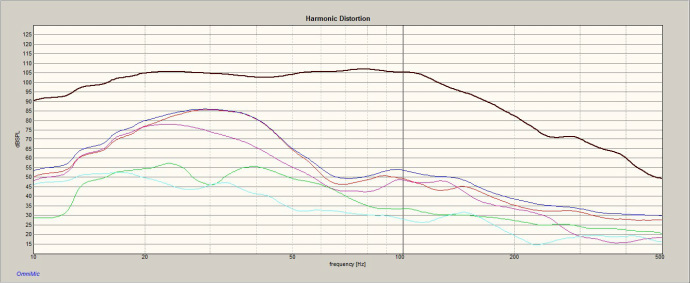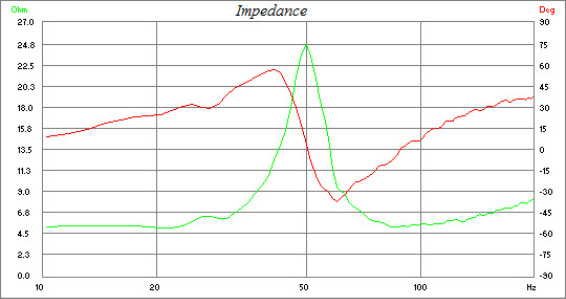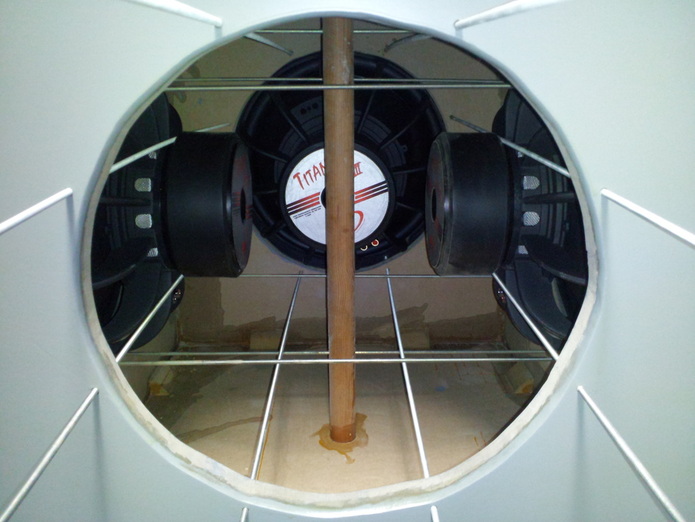NEW!
Super subwoofer: 4x 15" sealed 6kW.
The 4x15-TITAN.
Four cross-bolted Dayton (TIT400C-4) Titanic MKIII 15" woofers with vertical pillar: quality and inertia is guaranteed!

subwoofer harmonic distortion when eqed flat 20-100Hz 105 dB
Harmonic distortion is less than 10% @105 dB 1m (5dB/div). This is unmatched performance! No other sub manufacturer shows you this data -- ever wondered why?
(10-500Hz, 4 PEQ bands, 120Hz 4th order RL low-pass)

subwoofer near-field frequency response no eq
Nearfield response at 1, 10 and 100W with no EQ (subtract 13dB for 1m SPL equivalent). No compression is evident. Four PEQ bands were needed for flat SPL response like the top graph above.
EQ is mandatory for any subwoofer to output a flat response, irrespective wether near-or far field!
EQ is mandatory for any subwoofer to output a flat response, irrespective wether near-or far field!

The impedance shows the subs are tuned to 50Hz with a minimum impedance of 5 ohms.
Why choose the 4x15-TITAN?
This is simple: no other subwoofer on the consumer market offers this much linear displacement. Most use a single 8" or 10" driver, few use 12", only 1 two 15". We use FOUR 15" drivers per sub.
No amount of servo feedback (which we have nothing against per se) will make up for a driver's excursion limit, although this technique may linearize a driver if such is needed (ours don't). One brand ingeniously uses small drivers with high excursion ability and large (kW) amps to squeeze decent volume out of a small area (using high back EMF owing to the small box volume). Measurements show these too cannot do much at 20Hz.
We are convinced there is no substitute for sheer size and high efficiency, and our subs prove it! We only use sealed cabinets (no ports), which is critical for achieving an optimal transient response and hence musical realism. Our unique cross-bolting technique is another serious reason to choose PurestMusic subwoofers. While the woofers are pumping the cabinet doesn’t even vibrate slightly.
Each subwoofer is delivered without amplification or eq, but we provide optional amplifiers and processors proven affordable combinations playing flat down to 20Hz at 110dB (see graph above).
Woofer driver details:
http://www.daytonaudio.com/index.php/tit400c-4-15-titanic-mk-iii-subwoofer-4-ohm.html
SPECS:
- impedance: 4 Ohms
- power handling (RMS): 3.2 kW (!)
- power handling (max): 6.4 kW (!)
- frequency response: 10-200Hz
(recommended limits, 10-80 Hz if not near main speakers)
- sensitivity: 20Hz: 85dB, 60Hz 102dB @ 2.83Vrms/1m
- Qtc = 0.90
- Max SPL for <10%THD (EQed flat): 105dB
- 4 crossbolted counterballanced 15” drivers
- weight: 100 (drivers) + 50 (box) = 150 lbs
- dimensions: 26 x 24 x 24"(hxwxd box)+5 1/4" (h, casters)
- radiating surface: 498 sq. in, 3216 sq. cm
- displaced volume: 400 cubic inch, 6.6 litres
- 0.5 lbs Poly-fil/cubic ft
- finish as requested
- made in the USA
$2500 per 4x15-TITAN
We recommend at least 2 4x15-TITANs for smoother room integration and greater headroom.
$800:
Optional quiet pro amplifier (Yamaha P7000S) 1x3200W, 2x1600W (measured 15-40Hz driving the 4x15-TITAN).
We recommend 1 per 4x15-TITAN placed within 4 feet of it for highest damping factor.
$300:
Optional 2 channel 24bit 96kHz digital crossover (Behringer DCX2496) with PEQ set for flat near field response and your choice of hi-pass filters and limiter (several presets freely available upon request).
We'll gladly work with you if you'd want other equipment set up for use with our subs.
Free technical support.
Please allow 1 month production time per pair (on demand).
All prices exclude taxes and shipping charges.
Email us for a brochure or an audition!
info@purestmusic.com
CASE STUDY: WHY ADDING SUBS TO MAGNEPAN SPEAKERS IS AN AUDIOPHILE MUST
The Magnepan MG 3.6 (and newer 3.7) speakers are our references, as they represent the highest value affordable line source speaker on the market for the last 3 decennia. They do most things right with few trade-offs. They integrate very well with rooms due to their line-source dipolar nature if placed at least several feet from the back wall. However, bass is their single weak spot.
This weakness applies to most dipolar large panel speakers including electrostatics (e.g. Acoustat, Soundlab, Quad, Audiostatic) and magnetostatics (e.g. Magnepan, Apogee). This weakness comes about as bass quality is traded off against sensitivity (spacing to stator or magnet) and production cost (surface area, push vs. push-pull). This is one reason hybrids have come to the market, using dynamic woofers to handle the low frequencies. However, most of hybrids also have very limited low frequency ability.
Limited volume displacement
The PurestMusic 4x15-TITAN has the same surface area as the bass panel of our reference speaker the Magnepan 3.6 (498 vs. 537 square inches). However, the displaced volume of the 4x15-TITAN is an order of magnitude larger! The maximum linear excursion of our drivers is 21mm, while that of the MG 3.6 is only a few mm. The 4x15-TITAN can linearly displace 400 cubic inches of air (6.6 liters), whereas the MG 3.6 only about 50 cubic inches.
The reason these Maggies have such limited linear excursion is because it is not a push-pull design: the further the membrane travels from the magnets the lower the magnetic field strength. As the magnets are only a few mm thick, the flux drops of rapidly. This results in excessive 2nd order harmonic distortion, which is very audible in practice.
In other words, if you want clean bass at realistic sound levels the Maggies just won't do. Let's see what the maximum SPL is when "clean" audiophile-grade bass is required (THD <10% is our absolute maximum). The max SPL that can be played at 20 Hz at <10% THD is 83dB for the MG 3.6 but 105dB for our subwoofer. You may be aware that, according to the fundamental Fletcher-Munson curves, for a 20Hz tone to play subjectively as loud as an 80dB 1kHz tone (somewhat loud) requires ~110 dB SPL! In fact, a 20Hz tone below 75dB wont even be audible. Clearly, serious subwoofers are a must for large panel loudspeakers to play audiophile-grade realistic bass.
Limit the displacement!
But not only can the MG 3.6 not play realistic bass cleanly, you don't want them to! The reason is twofold. First, when playing low frequencies at decent levels the membrane moves back and forth through the non-uniform magnetic field. This in turn will modulate the loudness of higher frequencies played back at the same time. For example, a 200Hz tone will have a 20Hz SPL "envelope" around it.
The second reason is that, irrespective of magnet (or ESL!) field strength homogeneity (indeed in an ESL this is a non-issue), Doppler distortion will also modulate the higher frequencies, but now not the intensity but the waveform and apparent instantaneous frequency. This is due to the same effect that underlies the drop in pitch of an ambulance rapidly passing you. So, you really do want a sub for these reasons too.
The Magnepan MG 3.6 (and newer 3.7) speakers are our references, as they represent the highest value affordable line source speaker on the market for the last 3 decennia. They do most things right with few trade-offs. They integrate very well with rooms due to their line-source dipolar nature if placed at least several feet from the back wall. However, bass is their single weak spot.
This weakness applies to most dipolar large panel speakers including electrostatics (e.g. Acoustat, Soundlab, Quad, Audiostatic) and magnetostatics (e.g. Magnepan, Apogee). This weakness comes about as bass quality is traded off against sensitivity (spacing to stator or magnet) and production cost (surface area, push vs. push-pull). This is one reason hybrids have come to the market, using dynamic woofers to handle the low frequencies. However, most of hybrids also have very limited low frequency ability.
Limited volume displacement
The PurestMusic 4x15-TITAN has the same surface area as the bass panel of our reference speaker the Magnepan 3.6 (498 vs. 537 square inches). However, the displaced volume of the 4x15-TITAN is an order of magnitude larger! The maximum linear excursion of our drivers is 21mm, while that of the MG 3.6 is only a few mm. The 4x15-TITAN can linearly displace 400 cubic inches of air (6.6 liters), whereas the MG 3.6 only about 50 cubic inches.
The reason these Maggies have such limited linear excursion is because it is not a push-pull design: the further the membrane travels from the magnets the lower the magnetic field strength. As the magnets are only a few mm thick, the flux drops of rapidly. This results in excessive 2nd order harmonic distortion, which is very audible in practice.
In other words, if you want clean bass at realistic sound levels the Maggies just won't do. Let's see what the maximum SPL is when "clean" audiophile-grade bass is required (THD <10% is our absolute maximum). The max SPL that can be played at 20 Hz at <10% THD is 83dB for the MG 3.6 but 105dB for our subwoofer. You may be aware that, according to the fundamental Fletcher-Munson curves, for a 20Hz tone to play subjectively as loud as an 80dB 1kHz tone (somewhat loud) requires ~110 dB SPL! In fact, a 20Hz tone below 75dB wont even be audible. Clearly, serious subwoofers are a must for large panel loudspeakers to play audiophile-grade realistic bass.
Limit the displacement!
But not only can the MG 3.6 not play realistic bass cleanly, you don't want them to! The reason is twofold. First, when playing low frequencies at decent levels the membrane moves back and forth through the non-uniform magnetic field. This in turn will modulate the loudness of higher frequencies played back at the same time. For example, a 200Hz tone will have a 20Hz SPL "envelope" around it.
The second reason is that, irrespective of magnet (or ESL!) field strength homogeneity (indeed in an ESL this is a non-issue), Doppler distortion will also modulate the higher frequencies, but now not the intensity but the waveform and apparent instantaneous frequency. This is due to the same effect that underlies the drop in pitch of an ambulance rapidly passing you. So, you really do want a sub for these reasons too.

